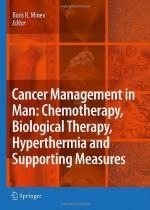|
This section contains 378 words (approx. 2 pages at 300 words per page) |
Hyperthermia is a condition in which internal body temperatures rise to dangerous and even lethal levels. These temperatures can reach anywhere between 104 and 115°F (40 and 46 °C). Hyperthermia affects many people during hot summer seasons. It is also a condition that occurs during some surgeries. In these rare cases the patient has an unpredictable reaction to surgical anesthesia, one of the symptoms being a rapid rise in body temperature. If not cared for immediately, patients who suffer hyperthermia, may be unaware of the symptoms and allow themselves to attain dangerous heat levels.
There are two levels or types of hyperthermia. One is heat exhaustion and is the less severe type of this condition. Symptoms are increasing fatigue or weakness. A state of anxiety is experienced. The patient experiences extreme levels of perspiration that drench clothing. The blood pressure is low (thready). This condition may lead to the collapse of the circulatory system. When this situation occurs, the patient is in danger. Additional symptoms are cold, pale and clammy skin. Disorientation may occur which may eventually lead to a shock-like unconsciousness.
The more serious form of hyperthermia is heatstroke (also called sunstroke). When this condition occurs, treatment must be administered immediately. The onset may be sudden and severe, but there are early warning signs. The patient may experience a headache, dizziness, and a general weakness. Perspiration or sweating usually decreases and the skin is hot and dry. The entire body appears flushed. The urine may become dark yellow or orange. The pulse rate increases rapidly and may reach 160 beats per minute. Unlike heat exhaustion, the blood pressure is not affected. A brief period of disorientation precedes unconsciousness or convulsions. Circulatory collapse is a dangerous condition that comes just before death. Some patients who survive heatstroke may have permanent brain damage.
Some other causes of hyperthermia may be over exercising in a hot climate, overeating, overdressing, or consumption of too much alcohol. In dry climates, many people do not realize their body temperatures are rising because of the lack of obvious perspiration. Constant rehydration by water or special fluids is highly recommended as a prevention measure. This helps the body's cooling mechanisms to work more efficiently and under greater stress. Fluids help maintain vital blood pressure levels.
|
This section contains 378 words (approx. 2 pages at 300 words per page) |


